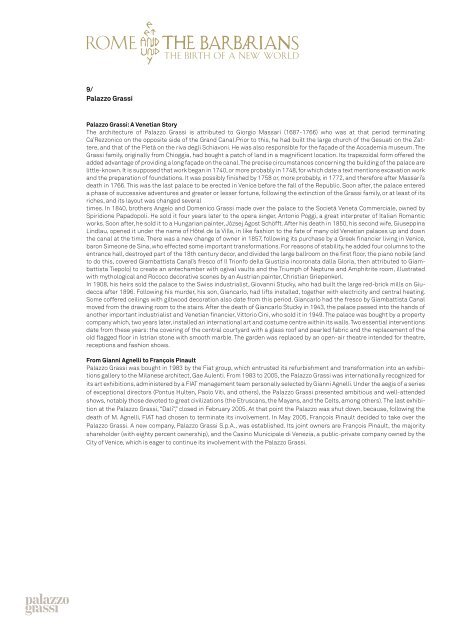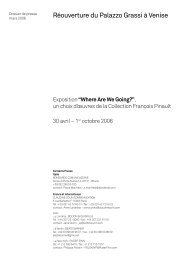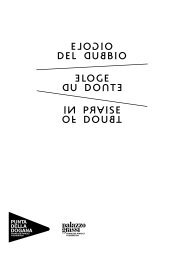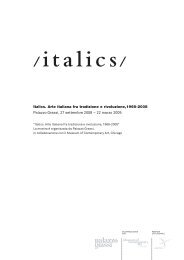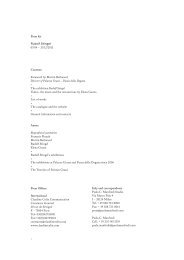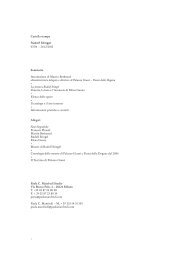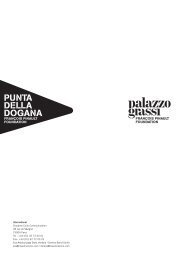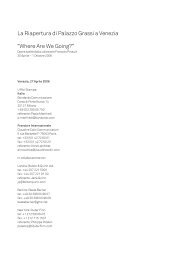pdf file, 819 Kb - Palazzo Grassi
pdf file, 819 Kb - Palazzo Grassi
pdf file, 819 Kb - Palazzo Grassi
You also want an ePaper? Increase the reach of your titles
YUMPU automatically turns print PDFs into web optimized ePapers that Google loves.
9/<br />
<strong>Palazzo</strong> <strong>Grassi</strong><br />
<strong>Palazzo</strong> <strong>Grassi</strong>: A Venetian Story<br />
The architecture of <strong>Palazzo</strong> <strong>Grassi</strong> is attributed to Giorgio Massari (1687-1766) who was at that period terminating<br />
Ca’Rezzonico on the opposite side of the Grand Canal.Prior to this, he had built the large church of the Gesuati on the Zattere,<br />
and that of the Pietà on the riva degli Schiavoni. He was also responsible for the façade of the Accademia museum. The<br />
<strong>Grassi</strong> family, originally from Chioggia, had bought a patch of land in a magnificent location. Its trapezoidal form offered the<br />
added advantage of providing a long façade on the canal. The precise circumstances concerning the building of the palace are<br />
little-known. It is supposed that work began in 1740, or more probably in 1748, for which date a text mentions excavation work<br />
and the preparation of foundations. It was possibly finished by 1758 or, more probably, in 1772, and therefore after Massari’s<br />
death in 1766. This was the last palace to be erected in Venice before the fall of the Republic. Soon after, the palace entered<br />
a phase of successive adventures and greater or lesser fortune, following the extinction of the <strong>Grassi</strong> family, or at least of its<br />
riches, and its layout was changed several<br />
times. In 1840, brothers Angelo and Domenico <strong>Grassi</strong> made over the palace to the Società Veneta Commerciale, owned by<br />
Spiridione Papadopoli. He sold it four years later to the opera singer, Antonio Poggi, a great interpreter of Italian Romantic<br />
works. Soon after, he sold it to a Hungarian painter, Józsej Agost Schöfft. After his death in 1850, his second wife, Giuseppina<br />
Lindlau, opened it under the name of Hôtel de la Ville, in like fashion to the fate of many old Venetian palaces up and down<br />
the canal at the time. There was a new change of owner in 1857, following its purchase by a Greek financier living in Venice,<br />
baron Simeone de Sina, who effected some important transformations. For reasons of stability, he added four columns to the<br />
entrance hall, destroyed part of the 18th century decor, and divided the large ballroom on the first floor, the piano nobile (and<br />
to do this, covered Giambattista Canal’s fresco of Il Trionfo della Giustizia incoronata dalla Gloria, then attributed to Giambattista<br />
Tiepolo) to create an antechamber with ogival vaults and the Triumph of Neptune and Amphitrite room, illustrated<br />
with mythological and Rococo decorative scenes by an Austrian painter, Christian Griepenkerl.<br />
In 1908, his heirs sold the palace to the Swiss industrialist, Giovanni Stucky, who had built the large red-brick mills on Giudecca<br />
after 1896. Following his murder, his son, Giancarlo, had lifts installed, together with electricity and central heating.<br />
Some coffered ceilings with giltwood decoration also date from this period. Giancarlo had the fresco by Giambattista Canal<br />
moved from the drawing room to the stairs. After the death of Giancarlo Stucky in 1943, the palace passed into the hands of<br />
another important industrialist and Venetian financier, Vittorio Cini, who sold it in 1949. The palace was bought by a property<br />
company which, two years later, installed an international art and costume centre within its walls. Two essential interventions<br />
date from these years: the covering of the central courtyard with a glass roof and pearled fabric and the replacement of the<br />
old flagged floor in Istrian stone with smooth marble. The garden was replaced by an open-air theatre intended for theatre,<br />
receptions and fashion shows.<br />
From Gianni Agnelli to François Pinault<br />
<strong>Palazzo</strong> <strong>Grassi</strong> was bought in 1983 by the Fiat group, which entrusted its refurbishment and transformation into an exhibitions<br />
gallery to the Milanese architect, Gae Aulenti. From 1983 to 2005, the <strong>Palazzo</strong> <strong>Grassi</strong> was internationally recognized for<br />
its art exhibitions, administered by a FIAT management team personally selected by Gianni Agnelli. Under the aegis of a series<br />
of exceptional directors (Pontus Hulten, Paolo Viti, and others), the <strong>Palazzo</strong> <strong>Grassi</strong> presented ambitious and well-attended<br />
shows, notably those devoted to great civilizations (the Etruscans, the Mayans, and the Celts, among others). The last exhibition<br />
at the <strong>Palazzo</strong> <strong>Grassi</strong>, “Dalí”,” closed in February 2005. At that point the <strong>Palazzo</strong> was shut down, because, following the<br />
death of M. Agnelli, FIAT had chosen to terminate its involvement. In May 2005, François Pinault decided to take over the<br />
<strong>Palazzo</strong> <strong>Grassi</strong>. A new company, <strong>Palazzo</strong> <strong>Grassi</strong> S.p.A., was established. Its joint owners are François Pinault, the majority<br />
shareholder (with eighty percent ownership), and the Casino Municipale di Venezia, a public-private company owned by the<br />
City of Venice, which is eager to continue its involvement with the <strong>Palazzo</strong> <strong>Grassi</strong>.


